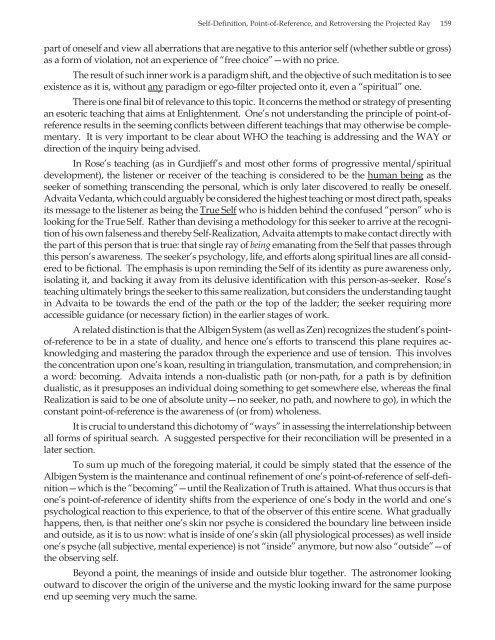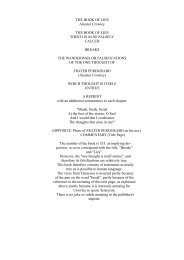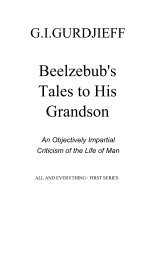Richard Rose’s Psychology of the Observer The Path to Reality Through the Self
John-Kent-Richard-Rose's-Psychology-of-Observer-Path-to-Reality-Thru-the-Self
John-Kent-Richard-Rose's-Psychology-of-Observer-Path-to-Reality-Thru-the-Self
You also want an ePaper? Increase the reach of your titles
YUMPU automatically turns print PDFs into web optimized ePapers that Google loves.
<strong>Self</strong>-Definition, Point-<strong>of</strong>-Reference, and Retroversing <strong>the</strong> Projected Ray 159<br />
part <strong>of</strong> oneself and view all aberrations that are negative <strong>to</strong> this anterior self (whe<strong>the</strong>r subtle or gross)<br />
as a form <strong>of</strong> violation, not an experience <strong>of</strong> “free choice”—with no price.<br />
<strong>The</strong> result <strong>of</strong> such inner work is a paradigm shift, and <strong>the</strong> objective <strong>of</strong> such meditation is <strong>to</strong> see<br />
existence as it is, without any paradigm or ego-filter projected on<strong>to</strong> it, even a “spiritual” one.<br />
<strong>The</strong>re is one final bit <strong>of</strong> relevance <strong>to</strong> this <strong>to</strong>pic. It concerns <strong>the</strong> method or strategy <strong>of</strong> presenting<br />
an esoteric teaching that aims at Enlightenment. One’s not understanding <strong>the</strong> principle <strong>of</strong> point-<strong>of</strong>reference<br />
results in <strong>the</strong> seeming conflicts between different teachings that may o<strong>the</strong>rwise be complementary.<br />
It is very important <strong>to</strong> be clear about WHO <strong>the</strong> teaching is addressing and <strong>the</strong> WAY or<br />
direction <strong>of</strong> <strong>the</strong> inquiry being advised.<br />
In <strong>Rose’s</strong> teaching (as in Gurdjieff’s and most o<strong>the</strong>r forms <strong>of</strong> progressive mental/spiritual<br />
development), <strong>the</strong> listener or receiver <strong>of</strong> <strong>the</strong> teaching is considered <strong>to</strong> be <strong>the</strong> human being as <strong>the</strong><br />
seeker <strong>of</strong> something transcending <strong>the</strong> personal, which is only later discovered <strong>to</strong> really be oneself.<br />
Advaita Vedanta, which could arguably be considered <strong>the</strong> highest teaching or most direct path, speaks<br />
its message <strong>to</strong> <strong>the</strong> listener as being <strong>the</strong> True <strong>Self</strong> who is hidden behind <strong>the</strong> confused “person” who is<br />
looking for <strong>the</strong> True <strong>Self</strong>. Ra<strong>the</strong>r than devising a methodology for this seeker <strong>to</strong> arrive at <strong>the</strong> recognition<br />
<strong>of</strong> his own falseness and <strong>the</strong>reby <strong>Self</strong>-Realization, Advaita attempts <strong>to</strong> make contact directly with<br />
<strong>the</strong> part <strong>of</strong> this person that is true: that single ray <strong>of</strong> being emanating from <strong>the</strong> <strong>Self</strong> that passes through<br />
this person’s awareness. <strong>The</strong> seeker’s psychology, life, and efforts along spiritual lines are all considered<br />
<strong>to</strong> be fictional. <strong>The</strong> emphasis is upon reminding <strong>the</strong> <strong>Self</strong> <strong>of</strong> its identity as pure awareness only,<br />
isolating it, and backing it away from its delusive identification with this person-as-seeker. <strong>Rose’s</strong><br />
teaching ultimately brings <strong>the</strong> seeker <strong>to</strong> this same realization, but considers <strong>the</strong> understanding taught<br />
in Advaita <strong>to</strong> be <strong>to</strong>wards <strong>the</strong> end <strong>of</strong> <strong>the</strong> path or <strong>the</strong> <strong>to</strong>p <strong>of</strong> <strong>the</strong> ladder; <strong>the</strong> seeker requiring more<br />
accessible guidance (or necessary fiction) in <strong>the</strong> earlier stages <strong>of</strong> work.<br />
A related distinction is that <strong>the</strong> Albigen System (as well as Zen) recognizes <strong>the</strong> student’s point<strong>of</strong>-reference<br />
<strong>to</strong> be in a state <strong>of</strong> duality, and hence one’s efforts <strong>to</strong> transcend this plane requires acknowledging<br />
and mastering <strong>the</strong> paradox through <strong>the</strong> experience and use <strong>of</strong> tension. This involves<br />
<strong>the</strong> concentration upon one’s koan, resulting in triangulation, transmutation, and comprehension; in<br />
a word: becoming. Advaita intends a non-dualistic path (or non-path, for a path is by definition<br />
dualistic, as it presupposes an individual doing something <strong>to</strong> get somewhere else, whereas <strong>the</strong> final<br />
Realization is said <strong>to</strong> be one <strong>of</strong> absolute unity—no seeker, no path, and nowhere <strong>to</strong> go), in which <strong>the</strong><br />
constant point-<strong>of</strong>-reference is <strong>the</strong> awareness <strong>of</strong> (or from) wholeness.<br />
It is crucial <strong>to</strong> understand this dicho<strong>to</strong>my <strong>of</strong> “ways” in assessing <strong>the</strong> interrelationship between<br />
all forms <strong>of</strong> spiritual search. A suggested perspective for <strong>the</strong>ir reconciliation will be presented in a<br />
later section.<br />
To sum up much <strong>of</strong> <strong>the</strong> foregoing material, it could be simply stated that <strong>the</strong> essence <strong>of</strong> <strong>the</strong><br />
Albigen System is <strong>the</strong> maintenance and continual refinement <strong>of</strong> one’s point-<strong>of</strong>-reference <strong>of</strong> self-definition—which<br />
is <strong>the</strong> “becoming”—until <strong>the</strong> Realization <strong>of</strong> Truth is attained. What thus occurs is that<br />
one’s point-<strong>of</strong>-reference <strong>of</strong> identity shifts from <strong>the</strong> experience <strong>of</strong> one’s body in <strong>the</strong> world and one’s<br />
psychological reaction <strong>to</strong> this experience, <strong>to</strong> that <strong>of</strong> <strong>the</strong> observer <strong>of</strong> this entire scene. What gradually<br />
happens, <strong>the</strong>n, is that nei<strong>the</strong>r one’s skin nor psyche is considered <strong>the</strong> boundary line between inside<br />
and outside, as it is <strong>to</strong> us now: what is inside <strong>of</strong> one’s skin (all physiological processes) as well inside<br />
one’s psyche (all subjective, mental experience) is not “inside” anymore, but now also “outside”—<strong>of</strong><br />
<strong>the</strong> observing self.<br />
Beyond a point, <strong>the</strong> meanings <strong>of</strong> inside and outside blur <strong>to</strong>ge<strong>the</strong>r. <strong>The</strong> astronomer looking<br />
outward <strong>to</strong> discover <strong>the</strong> origin <strong>of</strong> <strong>the</strong> universe and <strong>the</strong> mystic looking inward for <strong>the</strong> same purpose<br />
end up seeming very much <strong>the</strong> same.




